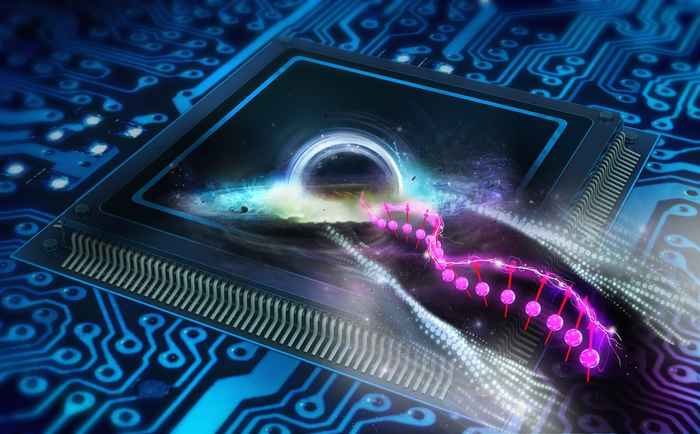NWO-ENW-Klein grant for developing black hole on a chip
Physicists receive 700,000 euros to make magnetic analogue of astronomical black holes
1 April 2021
The magnetic analogue black hole may be used to study fundamental aspects of black holes, such as Hawking radiation, that are hard to access for astronomical black holes. Furthermore, magnetic analogue black holes may find applications – for example, so-called black hole lasers – in the field of spintronics that aims to replace conventional electronics by using the magnetic ('spin') properties of electrons. This is expect to lead to more energy-efficient and sustainable information technology.
Analogue gravity
The field of analogue gravity studies laboratory analogues of gravitational systems, and, in particular, aims to gain insight in black holes — the most extreme objects in nature. Since the inception of analogue gravity, it has grown into an active interdisciplinary field that conceptually synergizes gravity and fluid dynamics. It has led to new physics such as white holes, objects that cannot be penetrated, as opposed to black holes, from which nothing — not even light — can escape. Analogue gravity is based on various physical systems, ranging from atomic Bose-Einstein condensates to water waves. A tunable solid-state platform that can be operated from high to low temperatures — corresponding, respectively, to classical and quantum regimes — and that can exhibit non-linearities is, however, not yet available.

Magnonic laser
The goal of this combined theory-experiment proposal is to realize gravity analogues with magnons, the quanta of oscillations in the magnetization direction, in metallic ferromagnets. In this implementation, theoretically proposed by Rembert Duine, changes in the electronic spin-current density are felt by magnons as an effective gravitational field. Because of the beneficial and tunable properties of magnetic materials, such as strong exchange interactions, magnonic gravity analogues can be operated over a wide range of temperatures. The ultimate objective is to realize a magnonic laser by means of a pair of white-hole and black-hole horizons that form a lasing cavity for the magnons.
Scientific challenges
The scientific challenges that the researchers need to overcome are to make the interaction between electronic spin current and magnons and the asymmetric exchange interaction sufficiently large in order to reach an operational window required for the gravity analogues. In the experiments, the researchers have proof that thin layers of magnetic metals can exhibit both the interaction of magnons with electronic spin current and asymmetric exchange. Moreover, the researchers have shown that these interactions are in principle tuneable by material combinations and thickness, interface engineering and focused-ion-beam irradiation, which provides an inroad for overcoming the scientific challenges.
The long-term perspective of the research project is twofold: First, the results will contribute to analogue gravity as the researchers' experimental realization, if successful, would provide the first tunable room-temperature black-hole analogue on a chip. Second, the results of the proposed research may be used in the field of magnonics as a new way to manipulate and on-chip amplify magnons for realizing beyond-Moore devices.